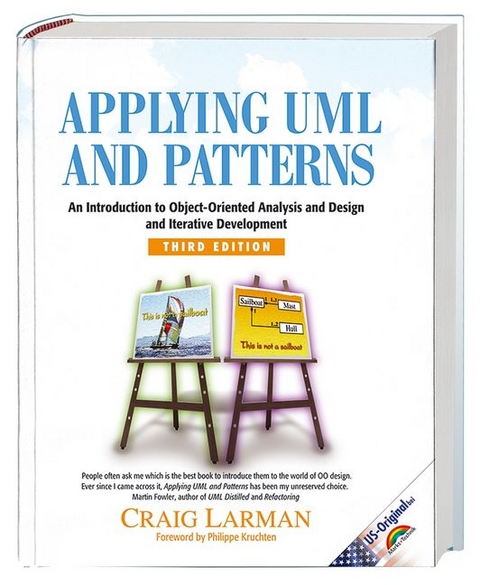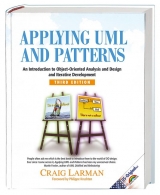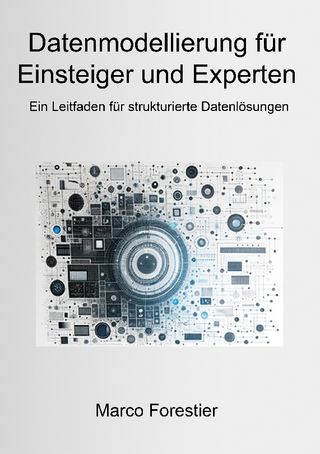Applying UML and Patterns
Markt & Technik Imprint in der Pearson Education Deutschland (Verlag)
978-3-8272-6898-3 (ISBN)
- Titel ist leider vergriffen;
keine Neuauflage - Artikel merken
0131489062 (die eine Ausgabe wurde in den USA gedruckt und die andere in Deutschland)
This edition contains Larmans usual accurate and thoughtful writing. It is a very good book made even better.
Alistair Cockburn, author, Writing Effective Use Cases and Surviving OO Projects
Too few people have a knack for explaining things. Fewer still have a handle on software analysis and design. Craig Larman has both.
John Vlissides, author, Design Patterns and Pattern Hatching
People often ask me which is the best book to introduce them to the world of OO design. Ever since I came across it Applying UML and Patterns has been my unreserved choice.
Martin Fowler, author, UML Distilled and Refactoring
This book is the worlds #1 business and college introduction to thinking in objectsand using that insight in real-world object-oriented analysis and design. Building on two widely acclaimed previous editions, Craig Larman has updated this book to fully reflect the new UML 2 standard, to help you master the art of object design, and to promote high-impact, iterative, and skillful agile modeling practices.
Developers and students will learn object-oriented analysis and design (OOA/D) through three iterations of two cohesive, start-to-finish case studies. These case studies incrementally introduce key skills, essential OO principles and patterns, UML notation, and best practices. You wont just learn UML diagramsyoull learn how to apply UML in the context of OO software development.
Drawing on his unsurpassed experience as a mentor and consultant, Larman helps you understand evolutionary requirements and use cases, domain object modeling, responsibility-driven design, essential OO design, layered architectures, Gang of Four design patterns, GRASP, iterative methods, an agile approach to the Unified Process (UP), and much more. This editions extensive improvements include
- A stronger focus on helping you master OOA/D through case studies that demonstrate key OO principles and patterns, while also applying the UML
- New coverage of UML 2, Agile Modeling, Test-Driven Development, and refactoring
- Many new tips on combining iterative and evolutionary development with OOA/D
- Updates for easier study, including new learning aids and graphics
- New college educator teaching resources
- Guidance on applying the UP in a light, agile spirit, complementary with other iterative methods such as XP and Scrum
- Techniques for applying the UML to documenting architectures
- A new chapter on evolutionary requirements, and much more
Applying UML and Patterns, Third Edition, is a lucid and practical introduction to thinking and designing with objectsand creating systems that are well crafted, robust, and maintainable.
About the Author:
Craig Larman has been developing software since 1978, and has been teaching object-oriented programming to adult students since 1986. He holds a B. Sc. and M. Sc. in computer science, and is the creator of the GRASP patterns, designed for users new to the object paradigm. He has personally taught and mentored more than 2,000 students, and is currently Principal Instructor at ObjectSpace, a company specializing in object technology.
Table of Content
Foreword.
Preface.
I. INTRODUCTION.
1. Object-Oriented Analysis and Design.
What Will You Learn? Is it Useful?
The Most Important Learning Goal?
What is Analysis and Design?
What is Object-Oriented Analysis and Design?
A Short Example.
What is the UML?
Visual Modeling is a Good Thing.
History.
Recommended Resources.
2. Iterative, Evolutionary, and Agile.
What is the UP? Are Other Methods Complementary?
What is Iterative and Evolutionary Development?
What About the Waterfall Lifecycle?
How to do Iterative and Evolutionary Analysis and Design?
What is Risk-Driven and Client-Driven Iterative Planning?
What are Agile Methods and Attitudes?
What is Agile Modeling?
What is an Agile UP?
Are There Other Critical UP Practices?
What are the UP Phases?
What are the UP Disciplines?
How to Customize the Process? The UP Development Case.
You Know You Didn't Understand Iterative Development or the UP When.
History.
Recommended Resources.
3. Case Studies.
What is and isn't Covered in the Case Studies?
Case Study Strategy: Iterative Development + Iterative Learning.
Case One: The NextGen POS System.
Case Two: The Monopoly Game System.
II. INCEPTION.
4. Inception is Not the Requirements Phase.
What is Inception?
How Long is Inception?
What Artifacts May Start in Inception?
You Know You Didn't Understand Inception When...
How Much UML During Inception?
5. Evolutionary Requirements.
Definition: Requirements.
Evolutionary vs. Waterfall Requirements.
What are Skillful Means to Find Requirements?
What are the Types and Categories of Requirements?
How are Requirements Organized in UP Artifacts?
Does the Book Contain Examples of These Artifacts?
Recommended Resources.
6. Use Cases.
Example.
Definition: What are Actors, Scenarios, and Use Cases?
Use Cases and the Use-Case Model.
Motivation: Why Use Cases?
Definition: Are Use Cases Functional Requirements?
Definition: What are Three Kinds of Actors?
Notation: What are Three Common Use Case Formats?
Example: Process Sale, Fully Dressed Style.
What do the Sections Mean?
Notation: Are There Other Formats? A Two-Column Variation.
Guideline: Write in an Essential UI-Free Style.
Guideline: Write Terse Use Cases.
Guideline: Write Black-Box Use Cases.
Guideline: Take an Actor and Actor-Goal Perspective.
Guideline: How to Find Use Cases.
Guideline: What Tests Can Help Find Useful Use Cases?
Applying UML: Use Case Diagrams.
Applying UML: Activity Diagrams.
Motivation: Other Benefits of Use Cases? Requirements in Context.
Example: Monopoly Game.
Process: How to Work With Use Cases in Iterative Methods?
History.
Recommended Resources.
7. Other Requirements.
How Complete are these Examples?
Guideline: Should We Analyze These Thoroughly During Inception?
Guideline: Should These Artifacts be at the Project Website?
NextGen Example: (Partial) Supplementary Specification.
Commentary: Supplementary Specification.
NextGen Example: (Partial) Vision.
Commentary: Vision.
NextGen Example: A (Partial) Glossary.
Commentary: Glossary (Data Dictionary).
NextGen Example: Business Rules (Domain Rules).
Commentary: Domain Rules.
Process: Evolutionary Requirements in Iterative Methods.
Recommended Resources.
III. ELABORATION ITERATION 1-BASICS.
8. Iteration 1-Basics.
Iteration 1 Requirements and Emphasis: Core OOA/D Skills.
Process: Inception and Elaboration.
Process: Planning the Next Iteration.
9. Domain Models.
Example.
What is a Domain Model?
Motivation: Why Create a Domain Model?
Guideline: How to Create a Domain Model?
Guideline: How to Find Conceptual Classes?
Example: Find and Draw Conceptual Classes.
Guideline: Agile Modeling-Sketching a Class Diagram.
Guideline: Agile Modeling-Maintain the Model in a Tool?
Guideline: Report Objects-Include 'Receipt' in the Model?
Guideline: Think Like a Mapmaker; Use Domain Terms.
Guideline: How to Model the Unreal World?
Guideline: A Common Mistake with Attributes vs. Classes.
Guideline: When to Model with 'Description' Classes?
Associations.
Example: Associations in the Domain Models.
Attributes.
Example: Attributes in the Domain Models.
Conclusion: Is the Domain Model Correct?
Process: Iterative and Evolutionary Domain Modeling.
Recommended Resources.
10. System Sequence Diagrams.
Example: NextGen SSD.
What are System Sequence Diagrams?
Motivation: Why Draw an SSD?
Applying UML: Sequence Diagrams.
What is the Relationship Between SSDs and Use Cases?
How to Name System Events and Operations?
How to Model SSDs Involving Other External Systems?
What SSD Information to Place in the Glossary?
Example: Monopoly SSD.
Process: Iterative and Evolutionary SSDs.
History and Recommended Resources.
11. Operation Contracts.
Example.
Definition: What are the Sections of a Contract?
Definition: What is a System Operation?
Definition: Postconditions.
Example: enterItem Postconditions.
Guideline: Should We Update the Domain Model?
Guideline: When Are Contracts Useful?
Guideline: How to Create and Write Contracts.
Example: NextGen POS Contracts.
Example: Monopoly Contracts.
Applying UML: Operations, Contracts, and the OCL.
Process: Operation Contracts Within the UP.
History.
Recommended Resources.
12. Requirements to Design-Iteratively.
Iteratively Do the Right Thing, Do the Thing Right.
Provoking Early Change.
Didn't All That Analysis and Modeling Take Weeks To Do?
13. Logical Architecture and UML Package Diagrams.
Example.
What is the Logical Architecture? And Layers?
What Layers are the Focus in the Case Studies?
What is Software Architecture?
Applying UML: Package Diagrams.
Guideline: Design with Layers.
Guideline: The Model-View Separation Principle.
What's the Connection Between SSDs, System Operations, and Layers?
Example: NextGen Logical Architecture and Package Diagram.
Example: Monopoly Logical Architecture?
Recommended Resources.
14. On to Object Design.
Agile Modeling and Lightweight UML Drawing.
UML CASE Tools.
How Much Time Spent Drawing UML Before Coding?
Designing Objects: What are Static and Dynamic Modeling?
The Importance of Object Design Skill over UML Notation Skill.
Other Object Design Techniques: CRC Cards.
15. UML Interaction Diagrams.
Sequence and Communication Diagrams.
Novice UML Modelers Don't Pay Enough Attention to Interaction Diagrams!
Common UML Interaction Diagram Notation.
Basic Sequence Diagram Notation.
Basic Communication Diagram Notation.
16. UML Class Diagrams.
Applying UML: Common Class Diagram Notation.
Definition: Design Class Diagram.
Definition: Classifier.
Ways to Show UML Attributes: Attribute Text and Association Lines.
Note Symbols: Notes, Comments, Constraints, and Method Bodies.
Operations and Methods.
Keywords.
Stereotypes, Profiles, and Tags.
UML Properties and Property Strings.
Generalization, Abstract Classes, Abstract Operations.
Dependency.
Interfaces.
Composition Over Aggregation.
Constraints.
Qualified Association.
Association Class.
Singleton Classes.
Template Classes and Interfaces.
User-Defined Compartments.
Active Class.
What's the Relationship Between Interaction and Class Diagrams?
17. GRASP: Designing Objects with Responsibilities.
UML versus Design Principles.
Object Design: Example Inputs, Activities, and Outputs.
Responsibilities and Responsibility-Driven Design.
GRASP: A Methodical Approach to Basic OO Design.
What's the Connection Between Responsibilities, GRASP, and UML Diagrams?
What are Patterns?
Where are We Now?
A Short Example of Object Design with GRASP.
Applying GRASP to Object Design.
Creator.
Information Expert (or Expert).
Low Coupling.
Controller.
High Cohesion.
Recommended Resources.
18. Object Design Examples with GRASP.
What is a Use Case Realization?
Artifact Comments.
What's Next?
Use Case Realizations for the NextGen Iteration.
Use Case Realizations for the Monopoly Iteration.
Process: Iterative and Evolutionary Object Design.
Summary.
19. Designing for Visibility.
Visibility Between Objects.
What is Visibility?
20. Mapping Designs to Code.
Programming and Iterative, Evolutionary Development.
Mapping Designs to Code.
Creating Class Definitions from DCDs.
Creating Methods from Interaction Diagrams.
Collection Classes in Code.
Exceptions and Error Handling.
Defining the Sale.makeLineItem Method.
Order of Implementation.
Test-Driven or Test-First Development.
Summary of Mapping Designs to Code.
Introduction to the NextGen POS Program Solution.
Introduction to the Monopoly Program Solution.
21. Test-Driven Development and Refactoring.
Test-Driven Development.
Refactoring.
Recommended Resources.
IV. ELABORATION ITERATION 2-MORE PATTERNS.
22. UML Tools and UML as Blueprint.
Forward, Reverse, and Round-Trip Engineering.
What is a Common Report of Valuable Features?
What to Look For in a Tool?
If Sketching UML, How to Update the Diagrams After Coding?
Recommended Resources.
23. Quick Analysis Update.
Case Study: NextGen POS.
Case Study: Monopoly.
24. Iteration 2-More Patterns.
From Iteration 1 to 2.
Iteration-2 Requirements and Emphasis: Object Design and Patterns.
25. GRASP: More Objects with Responsibilities.
Polymorphism.
Pure Fabrication.
Indirection.
Protected Variations.
26. Applying GoF Design Patterns.
Adapter (GoF).
Some GRASP Principles as a Generalization of Other Patterns.
"Analysis" Discoveries During Design: Domain Model.
Factory.
Singleton (GoF).
Conclusion of the External Services with Varying Interfaces Problem.
Strategy (GoF).
Composite (GoF) and Other Design Principles.
Facade (GoF).
Observer/Publish-Subscribe/Delegation Event Model (GoF).
Conclusion.
Recommended Resources.
V. ELABORATION ITERATION 3-INTERMEDIATE TOPICS.
27. Iteration 3-Intermediate Topics.
NextGen POS.
Monopoly.
28. UML Activity Diagrams and Modeling.
Example.
How to Apply Activity Diagrams?
More UML Activity Diagram Notation.
Guidelines.
Example: NextGen Activity Diagram.
Process: Activity Diagrams in the UP.
Background.
29. UML State Machine Diagrams and Modeling.
Example.
Definitions: Events, States, and Transitions.
How to Apply State Machine Diagrams?
More UML State Machine Diagram Notation.
Example: UI Navigation Modeling with State Machines.
Example: NextGen Use Case State Machine Diagram.
Process: State Machine Diagrams in the UP.
Recommended Resources.
30. Relating Use Cases.
The include Relationship.
Terminology: Concrete, Abstract, Base, and Addition Use Cases.
The extend Relationship.
The generalize Relationship.
Use Case Diagrams.
31. More SSDs and Contracts.
NextGen POS.
32. Domain Model Refinement.
New Concepts for the NextGen Domain Model.
Generalization.
Defining Conceptual Superclasses and Subclasses.
When to Define a Conceptual Subclass?
When to Define a Conceptual Superclass?
NextGen POS Conceptual Class Hierarchies.
Abstract Conceptual Classes.
Modeling Changing States.
Class Hierarchies and Inheritance in Software.
Association Classes.
Aggregation and Composition.
Time Intervals and Product Prices-Fixing an Iteration 1 "Error".
Association Role Names.
Roles as Concepts versus Roles in Associations.
Derived Elements.
Qualified Associations.
Reflexive Associations.
Using Packages to Organize the Domain Model.
Example: Monopoly Domain Model Refinements.
33. Architectural Analysis.
Process: When Do We Start Architectural Analysis?
Definition: Variation and Evolution Points.
Architectural Analysis.
Common Steps in Architectural Analysis.
The Science: Identification and Analysis of Architectural Factors.
Example: Partial NextGen POS Architectural Factor Table.
The Art: Resolution of Architectural Factors.
Summary of Themes in Architectural Analysis.
Process: Iterative Architecture in the UP.
Recommended Resources.
34. Logical Architecture Refinement.
Example: NextGen Logical Architecture.
Collaborations with the Layers Pattern.
Other Layer Pattern Issues.
Model-View Separation and "Upward" Communication.
Recommended Resources.
35. More Object Design with GoF Patterns.
Example: NextGen POS.
Failover to Local Services; Performance with Local Caching.
Handling Failure.
Failover to Local Services with a Proxy (GoF).
Designing for Non-Functional or Quality Requirements.
Accessing External Physical Devices with Adapters.
Abstract Factory (GoF) for Families of Related Objects.
Handling Payments with Polymorphism and Do It Myself.
Example: Monopoly.
Conclusion.
36. Package Design.
Package Organization Guidelines.
Recommended Resources.
37. UML Deployment and Component Diagrams.
Deployment Diagrams.
Component Diagrams.
38. Designing a Persistence Framework with Patterns.
The Problem: Persistent Objects.
The Solution: A Persistence Service from a Persistence Framework.
Frameworks.
Requirements for the Persistence Service and Framework.
Key Ideas.
Pattern: Representing Objects as Tables.
UML Data Modeling Profile.
Pattern: Object Identifier.
Accessing a Persistence Service with a Façade.
Mapping Objects: Database Mapper or Database Broker Pattern.
Framework Design with the Template Method Pattern.
Materialization with the Template Method Pattern.
Configuring Mappers with a MapperFactory.
Pattern: Cache Management.
Consolidating and Hiding SQL Statements in One Class.
Transactional States and the State Pattern.
Designing a Transaction with the Command Pattern.
Lazy Materialization with a Virtual Proxy.
How to Represent Relationships in Tables.
PersistentObject Superclass and Separation of Concerns.
Unresolved Issues.
39. Documenting Architecture: UML & the N+1 View Model.
The SAD and Its Architectural Views.
Notation: The Structure of a SAD.
Example: A NextGen POS SAD.
Example: A Jakarta Struts SAD.
Process: Iterative Architectural Documentation.
Recommended Resources.
VI. SPECIAL TOPICS
40. More on Iterative Development and Agile Project Management.
How to Plan an Iteration?
Adaptive versus Predictive Planning.
Phase and Iteration Plans.
How to Plan Iterations with Use Cases and Scenarios?
The (In)Validity of Early Estimates.
Organizing Project Artifacts.
You Know You Didn't Understand Iterative Planning When...
Recommended Resources.
Bibliography.
Glossary.
Index.
| Sprache | englisch |
|---|---|
| Maße | 240 x 190 mm |
| Gewicht | 1540 g |
| Einbandart | gebunden |
| Themenwelt | Mathematik / Informatik ► Informatik ► Programmiersprachen / -werkzeuge |
| Informatik ► Software Entwicklung ► UML | |
| Schlagworte | HC/Informatik, EDV/Programmiersprachen • Objektorientierte Programmierung • Rational Unified Process (RUP) • UML (Unified Modeling Language) |
| ISBN-10 | 3-8272-6898-2 / 3827268982 |
| ISBN-13 | 978-3-8272-6898-3 / 9783827268983 |
| Zustand | Neuware |
| Haben Sie eine Frage zum Produkt? |
aus dem Bereich




